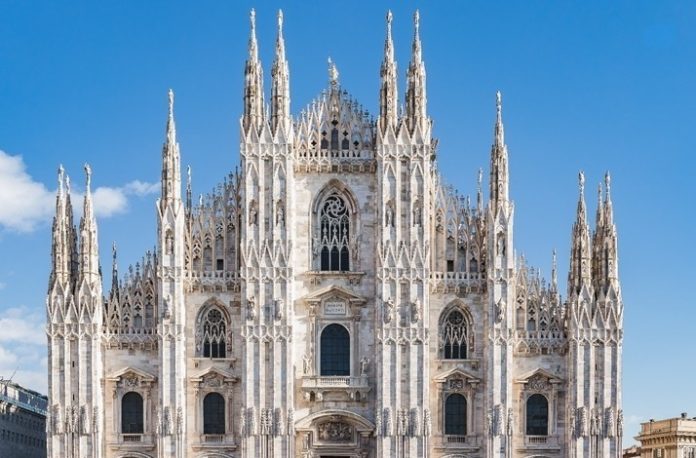The question of starting a 700-year long multi-billion-euro project only to realise that it is not worth it by completion doesn’t need a rocket scientist to answer it. In retrospect, that is enough to imprint a sense of judgement in a lunatic. The essence of the assignment is in its duration that it backfires and makes it inconsequential to its purpose. The majestic architectural masterpiece of a chronicle, The Milan Cathedral of Italy is one such example.
INTRODUCTION
The Milan Cathedral or Duomo di Milano in Italian or Metropolitan Cathedral-Basilica of the Nativity of Saint Mary located in Milan, Lombardy, Italy is Italy’s largest, Europe’s second-largest, world’s third-largest Cathedral and is the most visited tourist attraction in Milan. The majestic Duomo is to Milan what Victoria Memorial is to Kolkata. Gian Galeazzo Visconti’s accession to power in Italy came was when the project was initiated by Archbishop Antonio da Saluzzo in 1386. The gothic structure took nearly six centuries to complete(1386-1965) and is being dedicated to the Nativity of St Mary’s, the seat of the Archbishop of Milan, and currently Archbishop Mario Delphini, thereby making it not just a church but also a cathedral. A Renaissance masterpiece and a Catholic Church, it is a result of a journey of faith and art, brought to completion with science and engineering. The Architectural Masterpiece covers a surface of 109,641 square feet (the size of two football fields). The Edict of Milan which legalised Christianity making it the state religion of the Roman Empire was issued from the city in AD 313.
STRUCTURAL DESCRIPTIONS
The Milan Cathedral is 158 metres long, 92 metres wide, and 108.5 metres high, which is measured to the highest spire of Madonnina on the building, the Madonnina alone being 4.16 metres. The church has a Latin cross form covering 11,700 square metres with a capacity of 35,000 people. The church has five naves: a central nave and two lateral ones on each side resting on 40 columns, each 24.5 metres high. The highest part of the nave is about 45 metres high from the ground; it’s the highest nave in a complete church.
The roof is accessed through 6 stone stairways and two elevators; multiple sections of the roof are connected by 33 stone bridges in a crisscrossed manner. The facade’s entirety is covered with carved architectural elements portraying fruits, flowers, and fantastical beasts, including delightfully grotesque gargoyles.
HISTORY
Construction began from the apse, with its awe-inspiring stained-glass windows, and continued towards the transept and the first spans of the naves while the vault remains open, even today! Originally, the primary material was the traditional Lombard brick which Visconti changed to Candoglia marble from Lake Maggiore. In the 15th century, the greatest architects and artists of the time, including celebrity Polymath Leonardo Da Vinci, had their contribution in designing the Tiberium and between the 17th and 18th century it was completed with a great spire on top and subsequently followed by the laying of the statue of Madonnina in 1774. In the early 17th century, foundations of the new facade alongside five portals and two middle windows were built by Francesco Maria Richini and Fabio Mangone under the supervision of Federico Borromeo inspired by the pastoral work of Carlo Borromeo. However, considerable changes came with Carlo Buzzi who decided to change the facade to fit the Gothic style that was originally intended for the cathedral and also included the details within gigantic Gothic pilasters and two giant belfries. By the late 17th century, the facade was demolished when the covering of the roof was finished. Despite the involvement of new lead architects in the project with their ideas, Buzzi’s original vision was not discarded.
The facade was completed within seven years when Napoleon Bonaparte conquered Milan in the late 18th century, insisting that the church be completed before he was about to be crowned King of Italy and to celebrate the birth of Napoleon’s son inside the cathedral. He even assured that all expenses would be reimbursed by the French treasurer. Ambiguous generosity! Napoleon was inaugurated inside the cathedral, along with his statue being put at the top of one of the spires, but the reimbursement was never paid.
During the early 19th century, the stained glass windows were replaced with new models; missing arches and spires were added; final details and finishings were added in the 20th century- the last gate being inaugurated on January 1, 1965. During the 20th century’s two World Wars were when major renovation works were started-the first archaeological excavation in Piazza del Duomo and the completion of the facade with the addition of the five bronze doors at the front side of the church were done. Each of them has many patterns carved on it, depicting the stories in the Bible and the history of the church. The door in the middle is the largest among all five bronze doors, it weighs 37 tonnes, and depicts the life of the Virgin Mary. In August 1939, on World War 2 eve, a grey-green cloth was placed over the Madonnina to act as camouflage to avoid providing an easy target for bombers. But in vain, Allied forces did hit the Cathedral causing damage.
UNIQUE ASPECTS
The cathedral is unique in many respects and has plenty of reasons to be: the Madonnina statue which is 108.5 metres from the ground is used as a weather forecasting device; Milan is mostly a foggy-climate zone when the statue can be easily spotted from a distance, the Milanese think that it’s going to be a fair-weather day. Smartphones and weather apps have replaced the statue, no doubt. The Duomo hosts 3,400 statues – the largest number in any other building in the world, let alone a church; the largest statue among them, of Madonnina, is covered in 6,750 sheets of gold leaf gilding weighing half a tonne standing at the highest point of the roof. Something similar can be found in ‘Maa Kamakhya Temple’ in Guwahati, as the dome was gold plated with 20 kilogrammes of gold as a donation by Reliance Industries in late 2020.
Among the statues are images of saints and figures from the history of Christianity, and some peculiar ones too: sirens with double-ended fishtails, the portrait of boxer athlete Primo Carnera, and astonishingly, a face of a fascist leader of the 20th century, Benito Mussolini, strange to be in a house of faith which is based on liberty.
“Nothing’s ever built to last”, a lyric from the “Green Day” rock band. Milan Cathedral’s declining “health” is highlighted by the fact that the bells are seldom played to avoid the potential impact that its vibrations have on the church’s structure. It’s a wonder it lasts! Unlike most churches, Duomo, when it was consecrated on October 16, 1418, by Pope Martin V, its nave, one of the most significant parts of a church, was barely measured. Although most people agree on the official completion year is 1965, considering the frequent restoration that has been underway, it is debatable. The structure has lacked complete finishing due to politics, lack of money and indifference to a seemingly never-ending project. Earlier it was churches, today it is government-funded institutions spanning from health care to housing that is left behind due to Indian corruption.
Some have, however, managed to stand the test of time: a sundial that sits on the floor of the main entrance, though ancient is surprisingly precise- even used till now to regulate clocks throughout the city; the church houses three stained glass windows in the apse of the Cathedral, which are the tallest in the world. Shiveringly, the Duomo stores a nail from the Crucifixion of Jesus Christ; the Holy Nail is placed at a spot in the dome above the apse, marked by a small red light bulb. Every year, on the occasion of The Rite of Nivola on a Saturday closest to September 14, the archbishop of Milan ascends to the apex to retrieve the nail for exposing it to the public for three days. The monument is not completely about Christianity, but is a metaphorical history textbook: small embellishments depict laymen, fantastical creatures, fruits and flowers, heads and masks, and symbols to represent different vices and virtues – an intriguing register of the evolution of traditions and cultures over time.
POSITIVE IMPLICATIONS
The building of the cathedral brought about a significant amount of development: the cathedral’s primary marble was transported from Candoglia Querries which led to the building of canals to Milan. Post marble transportation, the Navigli canals remain, which have become a vibrant part of the city known for its art galleries, street markets and bars making Milan the most prosperous manufacturing and commercial city of Italy.
The world’s first lift was invented by Leonardo Da Vinci in the 15th century when he was tired of commuting up and down through the ladder to retrieve the Holy Nail from the Duomo. Since then, retrieving the Holy Nail has been achieved by lifting a boat-like lift. Today, multi-storey infrastructure is unthinkable without elevators.
NEGATIVE CONSEQUENCES
However, it isn’t free of negative consequences either: When the Pirelli skyscrapers surpassed the height of the Madonnina by a few metres in the 1960s, Milan passed a law stating that no new constructions can be higher than the revered statue and thereby outright sabotaging infrastructure development prospects, and along with it, economic development in the region.
The fortunes and manpower were used to build cathedrals of glory and symbols of power and God rather than invested in science, health, education, food, and water for all. Today, a nation’s majority budget is allocated to research and welfare development programmes and presently, the church management has started fundraising activities from March 29, 2021, for the makeup of funds lost during the pandemic-a macro shift.
CONCLUSION
On a concluding note, Milan Cathedral poses as a great example of how ideology was a dominating motivating factor and how beliefs and sentiments (although not reasonable) can bring about high quantitative collaboration. Science has just aided mankind in achieving its desires. Presently, after almost 21 years in the 21st century, mankind’s desires have remained the same and could very well be organised by MASLOW’S hierarchy of needs(in decreasing order of empowerment): whether it provides transcendental experiences; benefits of self-actualization; aesthetic edges, or looks; learning opportunities; reinforces esteem; a sense of security and physical pleasure. Religion, sacrifice, and building religious institutions all satiate the purpose of satisfying transcendental appetites; and even today, religious guru advises and exorcists activities are just mutated versions of the same.
In the 1300-1500 AD era, when the cathedral was being built, religion and faith formed a bigger group identity than anything in the western world. Now, professional and monetary worth have replaced humanity’s criteria for social and mass acceptance and there is nothing bigger a motivating force than money.
The construction of the Cathedral was meant to be looked at as a “reward” to the noble and working classes. Today, such rewards have taken the form of health insurance, a trip to Hawaii, employee benefits, and something that is a major player in American politics: federal tax cuts.
Napoleon, the most influential person of his era, might have experienced hubris while being inaugurated and celebrated his son’s birth in the Duomo. In contrast, US presidents are inaugurated on Capitol Hill staircases, and newborns in Italy are celebrated with roses and a “Birth Ribbon” embroidering the baby’s name, weight, length, and date of birth.
The church was supposed to be for performing religious rites and prayers, knowing and revising the lessons Christ taught of compassion, love, and liberty for the 6 million people that visit it annually. Ironically, the church is a fee-charging institution(18 euros for 72 hours of visit). Visiting the church is no longer “religious”, but a recreational triumph just like visiting the local theatre or a park. And hence, the Terraza is all entrepreneur ensembles; clarion kids; canoodling couples and youths with their most recent of cameras in their most revered of outfits enjoying the views across Milan’s clear days; rather than Christ faithful with clean dresses on their bodies and spirituality in their minds. Even 90s Bollywood heartthrob Madhuri Dixit takes it as an item of recreation rather than a site of religious worship (she was spotted posing in a black t-shirt and a denim jacket, in a church!).
The Jabberwockian relic was disliked by even some Christians of that time: for example., John Ruskin(1819-1900), a leading English art critic of the Victorian era commented: “…the cathedral steals from every style in the world…and every style spoiled…”; Henry James(1843-1916), a renowned American author commented on the Duomo: “A structure not supremely interesting, not logical, not … commandingly beautiful…”; Oscar Wilde(1854-1900) remarked:” The [Milan]Cathedral is an awful failure. Outside the design is monstrous and inartistic. The over-elaborated details stuck high up where no one can see them; everything is vile in it; it is, however, imposing and gigantic as a failure…”. Allegorically, it’s a white elephant; if mathematically comprehended, its utility is a line with a negative slope in the 2D coordinate axes. It’s just another Bahamas or Amsterdam. It started as an iPhone but ended as a Blackberry. But from an evolutionary perspective, and tracking the base of knowledge and development since the mediaeval era and the enlightenment, institutions like the Duomo are not of much utility but pose as a significant aspect of history that shaped humanity and developed ideologies through the medium of Christianity and today, Christianity is the most popular religion in the world.However, in the coming age of singularity, the significance of not just Christianity, but the religion umbrella itself is decreasing; and with the exponential growth in science and technology, it’s hard to assume its credibility is going to sustain for long. In the edited Shakespearean rhetoric, ‘so long as men practice blissful ignorance, so long lives this, and this gives life to nothing more than history’. In the Archpoet’s 21st century version, “Levity its matter, Like enough a withered leaf, a fragment of lost cause left for the sounds to penetrate and time to forget.”
By Deep Santu Pathak











